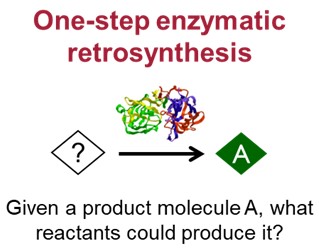AI/ML Biocatalytic Pathway Design and Synthesis
AI/ML Biocatalytic Pathway Design and Synthesis
Fatty acid methyl esters for soybean oil

The structural and stereochemical complexity of many natural product analogs and some synthetic small molecules can complicate the development of practical organic, or ‘chemo-catalytic’, routes, leaving enzymatic, or ‘biocatalytic’, routes as the primary source for drug discovery and commercial production. The design and engineering of these enzymatic routes requires an encyclopedic knowledge of the substrate scope and reactivity of known enzymes (~ 16,000 enzymatic transformations). Computer-Aided Synthesis Planning (CASP) tools in enzyme chemistry use rule-based methods and machine learning to generalize known reactions to predict enzymatic routes to a desired target. These CASP tools enable ‘retrosynthetic’ analyses of target compounds. This starts with the target molecule and works backward, piece by piece, to ultimately arrive at a set of simple precursors. Sankar and co-authors developed an enzymatic synthesis planning tool that is capable of proposing novel, greener approaches to manufacturing small molecules. Our retrosynthesis algorithm (Figure) detects experimentally tractable disconnection sites in a target compound, suggests the correct chemical reactions, candidate enzymes, and precursors needed to recreate those sites, and finally ranks all suggestions by the probability of success. Experienced biochemists could then utilize these results for idea generation while planning enzymatic synthesis routes. Our retrosynthesis search algorithm can also be applied in a recursive fashion to yield a multi-step synthesis plan that starts from simple, achiral commercially available building blocks.
Sankaranarayanan, K.; Heid, E.; W. Coley, C.; Verma, D.; H. Green, W.; F. Jensen, K. Similarity Based Enzymatic Retrosynthesis. Chemical Science 2022, 13 (20), 6039–6053. https://doi.org/10.1039/D2SC01588A.

For facile experimental implementation of the algorithm-predicted enzymatic routes, Sankar and co-authors have developed a chemical-biology platform that employs modern tools and methods in gene synthesis, protein purification and small molecule characterization. Lipid A served as a model target to illustrate this synthesis platform. Bacterially derived Lipid A and its variants are stimulants of innate immune responses that vary tremendously in their pro- as well as anti-inflammatory activities. The structural complexity of this natural product has long hindered the development of practical organic routes to yield a library of variants for drug discovery. To synthesize analogs of this glycolipid with novel immunomodulatory properties, Sankar and co-authors developed a fully reconstituted enzymatic platform comprised of 19 purified proteins (Fig 1B). This study harnesses DNA synthesis technology and technologies for heterologous expression and purification of enzymes to efficiently assemble an in vitro enzymatic pathway for production of analytically pure samples of product molecules for testing and analysis. It employs high resolution mass spectrometry and a systematic analysis of fragmentation patterns produced using a triple quadrupole mass spectrometer to elucidate the chemical structure of product molecules.
Sankaranarayanan, K.; Antaris, X. X.; Palanski, B. A.; El Gamal, A.; Kao, C. M.; Fitch, W. L.; Fischer, C. R.; Khosla, C. Tunable Enzymatic Synthesis of the Immunomodulator Lipid IVA To Enable Structure–Activity Analysis. J. Am. Chem. Soc. 2019, 141 (24), 9474–9478. https://doi.org/10.1021/jacs.9b03066.
